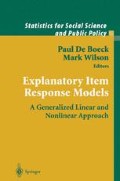Abstract
In this chapter, we discuss two extensions to the item response models presented in the first two parts of this book: more than one random effect for persons (multidimensionality) and latent item predictors. We only consider models with random person weights (following a normal distribution), and with no inclusion of person predictors (except for the constant). The extensions can be applied in much the same way to the other models that were discussed in the first two parts of this book.
Access this chapter
Tax calculation will be finalised at checkout
Purchases are for personal use only
Preview
Unable to display preview. Download preview PDF.
References
Ackerman, T. (1992). A didactic explanation of item bias, item impact, and item validity from a multidimensional perspective. Journal of Educational Measurement, 29, 67–91.
Ackerman, T. (1994). Using multidimensional item response theory to understand what items and tests are measuring. Applied Measurement in Education, 7, 255–278.
Adams, R.J., Wilson, M., & Wang, W.-C. (1997). The multidimensional random coefficients multinomial logit model. Applied Psychological Measurement, 21, 1–23.
Birnbaum, A. (1968). Some latent trait models and their use in inferring an examinee’s ability. In F.M. Lord & M.R. Novick (Eds). Statistical Theories of Mental Test Scores (pp. 397–479). Reading, MA: Addison-Wesley.
Bock, R.D., & Aitkin, M. (1981). Marginal maximum likelihood estimation of item parameters: An application of an EM-algorithm. Psychometrika, 46, 443–459.
Bock, R.D., Gibbons, R., & Muraki, E. (1988). Full-information item factor analysis. Applied Psychological Measurement, 12, 261–280.
Butter, R., De Boeck, P., & Verhelst, N. (1998). An item response model with internal restrictions on item difficulty. Psychometrika, 63, 47–63.
Christoffersson, A. (1975). Factor analysis of dichotomized variables. Psychometrika, 40, 5–22.
Embretson, S.E. (1991). A multidimensional latent trait model for measuring learning and change. Psychometrika, 56, 495–515.
Fischer, G.H. (1973). Linear logistic test model as an instrument in educational research. Acta Psychologica, 37, 359–374.
Folk, V.G., & Green, B.F. (1989). Adaptive estimation when the unidimen-sionality assumption of IRT is violated. Applied Psychological Measurement, 13, 373–389.
Fraser, C., & McDonald, R. (1986). NOHARM II: A FORTRAN program for fitting unidimensional and multidimensional normal ogive models of latent trait theory. Armidale, NSW, Australia: University of New England.
Kelderman, H. (1997). Loglinear multidimensional item response models for polytomously scored items. In W. van der Linden & R. Hambleton (Eds), Handbook of Modern Item Response Theory (pp. 287–304). New York: Springer.
Kelderman, H., & Rijkes, C.P.M. (1994). Loglinear multidimensional IRT models for polytomously scored items. Psychometrika, 59, 149–176.
Knol, D. & Berger, M. (1991). Empirical comparison between factor analysis and multidimensional item response models. Multivariate Behavioral Research, 26, 457–477.
Kupermintz, H., Ennis, M.M., Hamilton, L.S., Talbert, J.E., & Snow, R.E. (1995). Enhancing the validity and usefulness of large-scale educational assessments.1. Nels-88 Mathematics Achievement. American Educational Research Journal, 32, 525–554.
Luecht, R.M., & Miller, R. (1992). Unidimensional calibrations and interpretations of composite traits for multidimensional tests. Applied Psychological Measurement, 16, 279–293.
McDonald, R.R (1967). Nonlinear factor analysis. Psychometric Monographs, No. 15.
McDonald, R.P. (1997). Normal-ogive multidimensional model. In W.J. van der Linden & R.K. Hambleton (Eds). Handbook of Modern Rem Response Theory (pp.257–269). New York: Springer.
McKinley, R.L. (1989). Confirmatory analysis of test structure using multidimensional item response theory. Research Report No. RR-89–31, Princeton, NJ: ETS.
McKinley, R.L., & Reckase, M.D. (1983). MAXLOG: A computer program for the estimation of the parameters of a multidimensional logistic model. Behavior Research Methods and Instrumentation, 15, 389–390.
Muraki, E. & Carlson, J.E. (1995). Full-information factor analysis for polytomous item responses. Applied Psychological Measurement, 19, 73–90.
Muthén, B.O. (1978). Contributions to factor analysis of dichotomous variables. Psychometrika, 43, 551–560.
Reckase, M.D. (1997). A linear logistic multidimensional model for dichotomous item response data. In W. van der Linden & R. Hambleton (Eds), Handbook of Modern Rem Response Theory (pp. 271–286). New York: Springer.
Rijmen, F., & De Boeck, P. (2002). The random weights linear logistic test model. Applied Psychological Measurement, 26, 269–283.
Verbeke, G., & Molenberghs, G. (1997). Linear Mixed Models in Practice: A SAS-Oriented Approach. New York: Springer.
Walker, C.M., & Beretvas, S.N. (2000). Using multidimensional versus unidimensional ability estimates to determine student proficiency in mathematics. Paper presented at the 2000 Annual Meeting of the American Educational Research Association, New Orleans, LA.
Wang, W.-C., Wilson, M., & Adams, R.J. (1997). Rasch models for multidi-mensionality between items and within items. In M. Wilson, K. Draney, & G. Eglehard (Eds), Objective Measurement (Vol. 4,). Norwood, NY: Ablex.
Wilson, D., Wood, R. & Gibbons, R. (1984). TESTFACT. Test Scoring, Item Statistics and Item Factor Analysis [Computer software and manual]. Mooreville, IN: Scientific Software.
Editor information
Editors and Affiliations
Rights and permissions
Copyright information
© 2004 Springer Science+Business Media New York
About this chapter
Cite this chapter
Rijmen, F., Briggs, D. (2004). Multiple person dimensions and latent item predictors. In: De Boeck, P., Wilson, M. (eds) Explanatory Item Response Models. Statistics for Social Science and Public Policy. Springer, New York, NY. https://doi.org/10.1007/978-1-4757-3990-9_8
Download citation
DOI: https://doi.org/10.1007/978-1-4757-3990-9_8
Publisher Name: Springer, New York, NY
Print ISBN: 978-1-4419-2323-3
Online ISBN: 978-1-4757-3990-9
eBook Packages: Springer Book Archive

